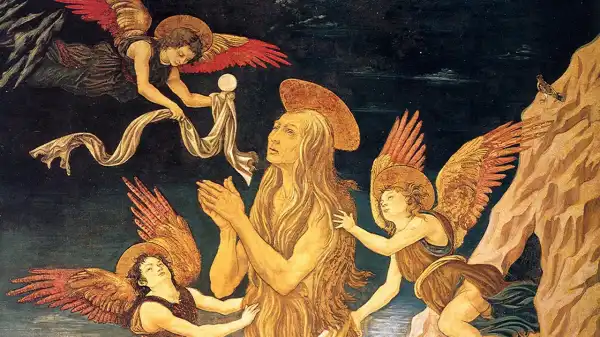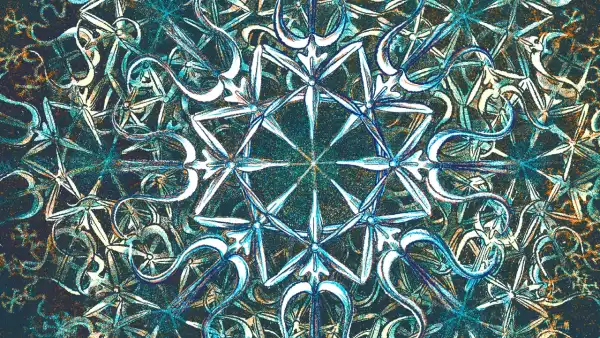
Save this storySave this storySave this storySave this story
On the wall of my father’s study was an ancient painting of a naked woman. Frail, stricken, and wild-haired, she mused on temporal and spatial distances, as saints and mystics do. Like many of the disturbing religious artifacts scattered around the rectory where I spent my childhood, I hadn’t paid much attention to the unkempt icon until I recently became interested in Mary Magdalene and became immersed in the controversies surrounding her.
Magdalene is the most famous woman in Christianity after the mother of Jesus; she may also be the most discussed figure in the New Testament. A companion of Jesus in all four Gospels, she is present at his tomb and, in some versions, is the first to see him after his Resurrection. In the Book of John, Jesus tells her to share the good news of his return with the other disciples, leading Thomas Aquinas, the 13th-century theologian, to call her “the apostle of the apostles.” Yet Magdalene has been criticized by church fathers over the centuries; today, feminist scholars are championing her.
Magdalene, mentioned only fourteen times in Scripture, is one of at least six women named Mary. This multitude of Marys creates considerable room for disagreement about which biblical threads actually connect to Magdalene’s story and which do not. In the Eastern Orthodox Church, she has a long, uncontested history of veneration. In the West, she has been sanctified but also depicted as a sinner, a nun, a mystical figure, and the wife of Jesus. She remains, above all, a figure of the margins. The patron saint of outcasts, she symbolizes uncertainty.
“There are a lot of disparate accounts,” Elaine Pagels, a noted religious scholar, told me on the porch of her home in Princeton, New Jersey. To make the point, Pagels pulled out a copy of The New Oxford Annotated Bible, leafing through the books of Matthew, Mark, Luke, and John, and dwelling on the differences in their accounts of the Magdalene. “The New Testament writers didn’t seem to be very interested in women except in minor roles,” she noted. She studied the book of Luke to show me how the author downplayed Mary Magdalene. She is present at the Resurrection, but only among other women. Instead of meeting the risen Lord, the women see two angels. “Luke minimizes her role,” Pagels said.
Pagels’s expertise, however, goes far beyond the four gospels that had become the official canon by the early fifth century. She has examined a much broader corpus of texts, many of which feature women in more authoritative roles. Consider, she suggests, the Gospel of Philip, a third-century text discovered along with similar documents near Nag Hammadi, Egypt, in 1945, which describes Magdalene as the woman “who was always with the Lord” and “the one who was called his companion.” In its narrative, her significant influence extends beyond the earthly. As Pagels puts it, “she is seen as a manifestation of divine wisdom.”
In addition to icons of anorexic saints, my childhood home was also filled with books. Pagels’s Gnostic Gospels shared a shelf with Emily Dickinson’s Complete Poems and Carl Jung’s Memories, Dreams, Reflections. Each, in its own way, expressed a friendly skepticism of orthodoxy and gave value to people and ideas previously considered marginal. As Dickinson wrote, “Tell the whole truth, but tell it askew.”
Mary Magdalene is a cipher for an oblique truth; to unravel her story requires a divine imagination. Beyond the occasional mentions in Scripture, there is a vast treasury of myths. My favorite, a 13th-century French tale known as the Golden Legend, tells of Magdalene and Jesus’s friend Lazarus, who in this and other stories is said to be her brother. With a handful of followers, they board a boat fourteen years after Jesus’s crucifixion and land on the southern coast of France. There Magdalene lives and teaches until her death. Two rival French monasteries still claim to hold her relics. On July 22, her feast day, they honor her as their patron saint.
Magdalene becomes a more complex figure because of her associations with sexual desire: in the popular imagination, she is a repentant prostitute. However, as I learned more about who Mary Magdalene was, I was surprised to learn that there is nothing in the New Testament that links her to promiscuity. Instead, this claim arose from a series of sermons preached by Pope Gregory in 591. Gregory argued that
Sourse: newyorker.com






